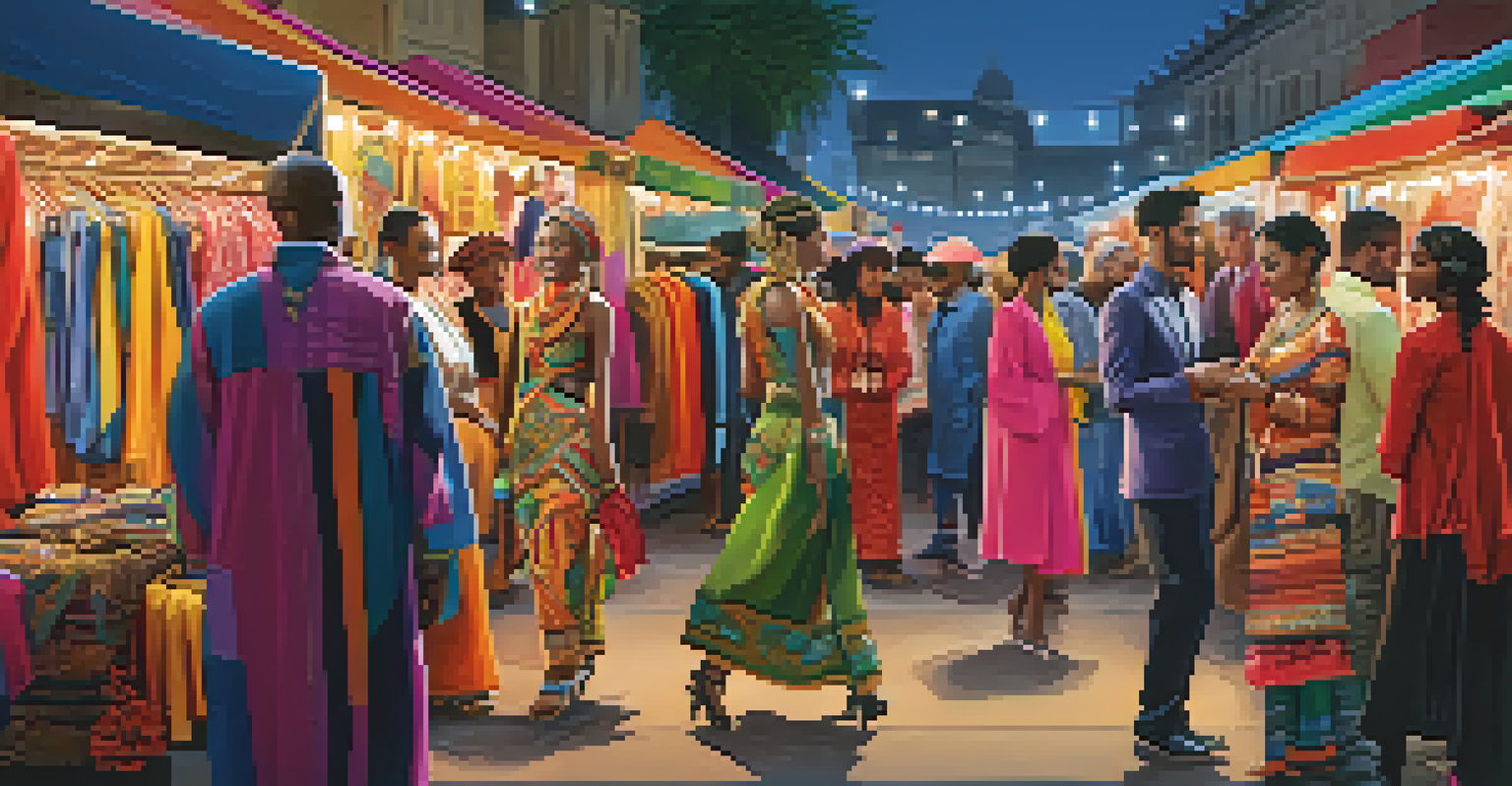How Globalization Shapes Fashion Trends Across the World Today

Understanding Globalization in the Fashion Context
Globalization refers to the interconnectedness of economies, cultures, and people across the world. In the fashion industry, this means that trends can emerge from anywhere and reach consumers globally in an instant. For example, a street style trend from Tokyo can inspire designers in New York, showcasing how cultural influences cross borders effortlessly.
Fashion is the armor to survive the reality of everyday life.
This interconnectivity not only influences what we wear but also how we perceive style. It fosters a blend of traditional and contemporary elements, creating unique fashion statements that honor diverse backgrounds. As a result, consumers are increasingly exposed to a variety of styles and trends from different cultures, enriching their own fashion choices.
Moreover, globalization has led to a more inclusive approach to fashion, as designers are now more aware of varied cultural aesthetics. This awareness encourages collaboration and innovation, allowing fashion to evolve in exciting ways. As we explore globalization's impact, it becomes clear that it shapes our wardrobes in profound and colorful ways.
The Role of Social Media in Fashion Globalization
Social media platforms like Instagram and TikTok have revolutionized how fashion trends spread globally. These platforms allow fashion enthusiasts and influencers to showcase their styles, making trends accessible to a wider audience. For instance, a viral TikTok dance might feature a unique outfit that quickly becomes a global sensation, inspiring countless imitations.

Through social media, fashion is no longer confined to runways or magazines. Instead, it thrives in the digital realm, where anyone can become a trendsetter. This democratization of fashion means that styles from diverse cultures can gain popularity, reflecting a more globalized perspective on what is considered 'in' or 'out.'
Globalization Shapes Fashion Trends
The interconnectedness of cultures allows diverse fashion influences to inspire trends worldwide.
Additionally, social media allows for real-time feedback and interaction, making the fashion world more responsive to consumer preferences. Designers can gauge the popularity of their collections almost instantly, tailoring their offerings to align with global tastes. This dynamic relationship between social media and fashion underscores the power of globalization in shaping trends.
Cultural Exchange: A Two-Way Street
Globalization promotes a two-way exchange of cultural elements, particularly in fashion. While Western fashion often influences other regions, we also see traditional garments and styles making their way into mainstream fashion. For example, the rise of the kimono jacket in Western wardrobes highlights the appreciation for diverse cultural aesthetics.
Globalization is a process that transforms the world into a single market, where local cultures can be both lost and revitalized.
This cultural exchange enriches the fashion landscape, allowing for a fusion of styles that reflects our global society. Designers often draw inspiration from various cultures, leading to innovative combinations that might not have existed otherwise. This blending creates unique fashion statements that celebrate diversity and foster understanding.
However, it's essential to approach cultural exchange thoughtfully, avoiding appropriation and instead honoring the origins of these styles. By doing so, fashion can be a powerful medium for connection and respect, showcasing the beauty of our interconnected world while ensuring that cultural narratives are preserved.
Fast Fashion: The Double-Edged Sword of Globalization
Fast fashion has emerged as a prominent aspect of globalization, allowing consumers to access trendy clothing at affordable prices. Brands like Zara and H&M exemplify this trend, rapidly producing garments that reflect current styles. While this model caters to consumer demand for variety, it also raises questions about sustainability and ethical production.
The fast fashion industry often relies on global supply chains, which can lead to environmental degradation and exploitative labor practices. As consumers become more aware of these issues, there is a growing demand for transparency and responsibility within the industry. This shift is prompting brands to reevaluate their practices and consider more sustainable approaches.
Social Media Drives Fashion Forward
Platforms like Instagram and TikTok democratize fashion, enabling real-time sharing and trendsetting.
Navigating the fast fashion landscape requires a balance between accessibility and ethical considerations. As globalization continues to shape fashion trends, it is vital for consumers, brands, and designers to prioritize sustainability and respect for workers. This awareness can lead to a more responsible fashion industry that values both style and ethics.
Sustainable Fashion: A Global Movement
As globalization exposes the environmental impact of fashion, a growing movement toward sustainability is taking shape. Consumers are increasingly seeking brands that prioritize eco-friendly materials and ethical production practices. This shift is creating a demand for transparency and accountability, prompting brands to adapt to changing consumer preferences.
Sustainable fashion is not just a trend but a necessity for the future of the industry. Initiatives like the Fashion Revolution and various eco-conscious brands are leading the charge towards a more sustainable approach. By embracing innovative materials and circular fashion practices, the industry can reduce its carbon footprint and promote responsible consumption.
Moreover, this global movement encourages collaboration across borders, as designers and brands share ideas and resources. By working together, the fashion industry can tackle pressing issues like waste and pollution, fostering a more sustainable future. This collective effort demonstrates that when it comes to fashion, sustainability is not just a choice, but a shared responsibility.
Local Trends in a Globalized Fashion World
While globalization influences fashion trends, local styles and traditions continue to thrive. Many regions maintain their unique fashion identities, blending global influences with local craftsmanship. For example, African prints and Indian embroidery have gained recognition on the global stage, showcasing the beauty of local artistry.
These local trends often serve as a counterbalance to the fast-paced nature of global fashion. By celebrating traditional techniques and materials, communities can preserve their cultural heritage while participating in the global fashion dialogue. This fusion of global and local creates a rich tapestry of fashion that reflects the diversity of human expression.
Globalization Shapes Fashion Trends
The interconnectedness of cultures allows for diverse fashion influences to emerge and evolve globally.
Additionally, local designers are increasingly gaining visibility through platforms that promote their work. This exposure allows them to reach a wider audience while remaining true to their roots. In a globalized world, the appreciation of local trends enhances the overall fashion landscape, creating a more inclusive and vibrant industry.
The Future of Global Fashion Trends
As we look to the future, the impact of globalization on fashion trends is likely to deepen. With advancements in technology and communication, the exchange of ideas and styles will only accelerate. Virtual fashion shows and digital marketplaces are becoming more prevalent, allowing designers and consumers to connect across borders seamlessly.
This digital landscape will continue to shape consumer behavior, as people become more discerning about their fashion choices. The rise of influencers and online communities will play a crucial role in driving trends, allowing for a more participatory approach to fashion. This shift could lead to a more personalized and diverse fashion ecosystem that reflects individual identities.

Ultimately, the future of fashion will be defined by a balance between global influences and local authenticity. As designers and consumers navigate this evolving landscape, the focus on sustainability, inclusivity, and cultural appreciation will be paramount. Embracing these values will pave the way for a fashion industry that celebrates diversity while fostering global connections.